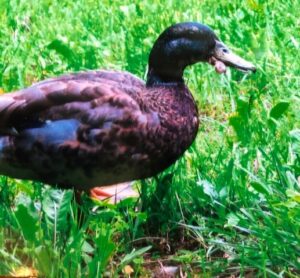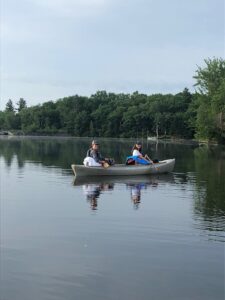For various valid reasons, we are discouraged by Mass Audubon and MassWildlife from feeding wild ducks and geese. Here are some reasons given:
- Feeding attracts large concentrations of waterfowl to areas that can’t naturally support such numbers. Left on their own, ducks and geese will occupy areas that provide sufficient natural food. As they deplete food in one location, they fly to new feeding areas, often miles away.
- Artificial feeding encourages unnaturally large flocks to gather in one place where the competition for food can cause unnecessary stress. This may weaken the birds and make them more susceptible to disease.
- Artificial feeding may allow frail birds to survive, reproduce, and diminish the species as a whole. Mortality is normally high in bird populations—it’s a natural mechanism, important in maintaining populations that the environment can support.
- Feeding may encourage species of waterfowl not normally found in the area to concentrate. This can lead to an increased incidence of hybridization, which can eventually weaken the gene pool in certain species. This is a rising problem in Mallard and Black Duck populations in Massachusetts.
- Deposits of fecal matter can affect water quality and compromise human health. Children can also come into contact with droppings left on the surrounding landscape. Also, birds crowded into these areas are often defecating in the same location where they’re feeding.
- Ducks and geese are well suited to survive New England winters. Their feathers provide air pockets that stabilize body temperature and control heat loss. When birds fluff their feathers, they are merely increasing the air space and insulation. Waterfowl sitting with puffed feathers on a frozen pond are perfectly fine and do not need our help.
Ron Smith, a well-known area outdoor sportsman, knows this. He and his wife Jan live on the shores of Onota Lake in Pittsfield and have close encounters with ducks and geese daily. He made one exception to the “no feeding” rule.
Two summers ago, a male mallard duck (drake) came up on their shore. Ron noticed something wrong with that duck and thought it had a broken beak and had trouble moving its mouth. There was a mass of something sticking out on the side of his mouth (turned out it was his shriveled-up tongue). He tried to eat but had difficulty. Not only that, the other ducks picked on him and chased him away. Ron suspected that the damage could have been caused by being hooked in the mouth with a fishing lure and perhaps damaged himself trying to flee. Perhaps a turtle did the damage.
Ron took pity on the poor quacker and tried feeding him dried whole kernel, whole wheat bread and “quack snacks”, but he had trouble sucking food up, he could only scoop things up, one kernel at a time with difficulty. To Ron’s amazement, the duck let him put food in his mouth, especially when he soaked the bread in water first. According to Ron, that’s his favorite. Now, when the duck sees Ron, he runs up to him wanting food, and of course Ron accommodates him. Since last summer and all through the winter, he has been feeding it this way.
Ron guesses that he is probably 3 years old now. He and his wife Jan named him “Raymour”. He can fly, but he spent last winter there on Onota Lake. He would waddle up from the lake twice a day for Ron to feed him. He would even come up when the snow was chest deep for him. The Smiths have a fairly long, steep lawn sloping to the lake. “You should see that duck, in the winter pushing snow with its breast to get up to their house.” said Ron.
Raymour can’t quack but he does make a clicking sound, which Ron has mastered, and the duck responds to him. (New research suggests that some birds may know who their human friends are, as they are able to recognize people’s faces and differentiate between human voices). Beside the clicking sound, he has a funny habit of fluffing up and shaking his wings when he sees Ron (like a baby bird would do).
Lately, there has been a female Mallard that must have watched Raymour and now comes running up to Ron to get a handout. But he’s trying to discourage her because he doesn’t want her to lose her fear of humans (and to rely on handouts rather than to find her own food in the wild).
“I can justify my feeding the damaged Drake, he would have died without my help.” said Ron.
I say Kudos to Ron. It just seems that was the right thing to do.
TU Chapter honored the reopening of the Bridge of Flowers with donated stone benches
Recently, in an on-site ceremony, Deerfield River Watershed Trout Unlimited (DRWTU) unveiled new stone benches in downtown Shelburne Falls, to help celebrate the re-opening of the Bridge of Flowers, after being closed due to Covid-19, and to highlight the importance of the Deerfield River.
DRWTU’s mission is to conserve, protect, and enhance the Deerfield River Watershed and its cold-water fisheries. “This is a great opportunity to let visitors know how important the Deerfield River is to this region and to welcome them to the historic Bridge of Flowers,” said Kevin Parsons, past president of DRWTU who spearheaded the effort.
Visitors to Shelburne Falls will now have a new place to sit and rest after a busy shopping, sightseeing, floating and fishing day, with the benches located appropriately near the Bridge of Flowers, just behind State Street’s West End Pub. The Bridge of Flowers welcomes more than 60,000 visitors per year, according to Bridge of Flowers Committee Chair Annette Szpila.
The benches would not be possible without the generosity of Ashfield Stone Company of Shelburne Falls that produced and largely donated them. JS Rae, also of Shelburne Falls, delivered and placed the benches in their current location behind West End Pub, at 16 State Street.
Although not located in the Berkshires, events dealing with the Deerfield River are usually carried in this column. There are lots of people from the Berkshires, especially northern Berkshires, who travel over the mountain to flyfish and float this exceptional river.
Want to experience a quiet, peaceful lake? Get up and out early.
There’s something about being on a lake at the crack of dawn on a warm summer morning. The lake is usually calm as a mirror and there’s no telling what you might encounter on it.
I was out trolling for crappie on Ashmere Lake last Sunday using an electric motor to propel my old rowboat. Around 5:30 am, out of the morning fog appeared the two young ladies (pictured) paddling their canoe., and they appeared to be having a ball. I asked them what time they started paddling and they said around 5:15 am. They allowed me to take a picture of them for this column and we exchanged email addresses so that I could send the picture to them and perhaps get their names. Well, don’t you know, their email address accidentally got deleted from my cell phone. So, ladies, if you contact me at the address below, I will gladly send you the pictures. 
Later, around 7:00 am two young fellas trolled past me in a pram. They had a boom box in their boat and as they were fishing, they were singing along with the music and having a grand old time. The music wasn’t loud or offensive at all, and it was kind of nice to see. A little later, some serious bass fishermen arrived and steered their bass boats into the various coves.
That morning, I saw two bald eagles, (one adult and one premature,) a blue heron, many ducks and geese and from afar (probably Cleveland Reservoir), I heard that unmistakable call of loons. I trolled past three separate snapping turtles; with one being quite large. I had to pull my lure out of the water when I approached them because they wanted to eat it. Last thing I want is an encounter with one of them.
After catching a sufficient number of crappies for a fish fry I headed back to shore. Ah, it doesn’t get much better than that.
